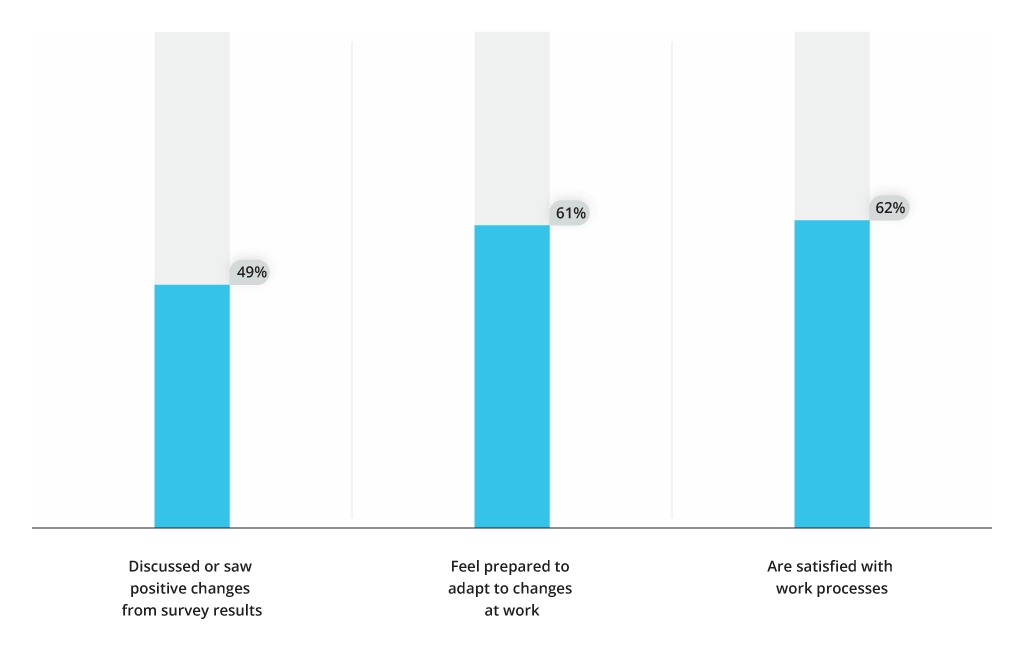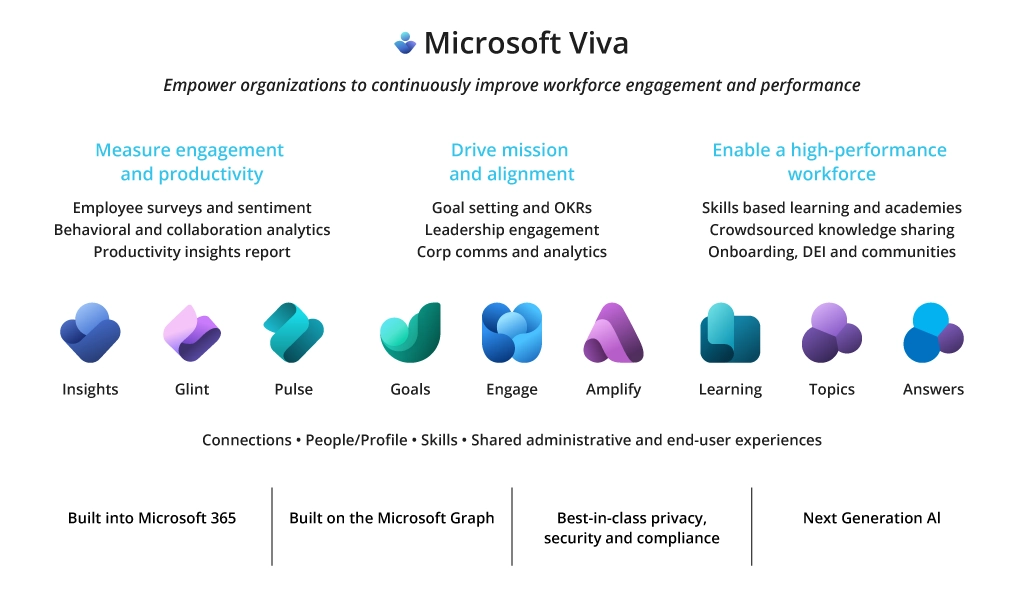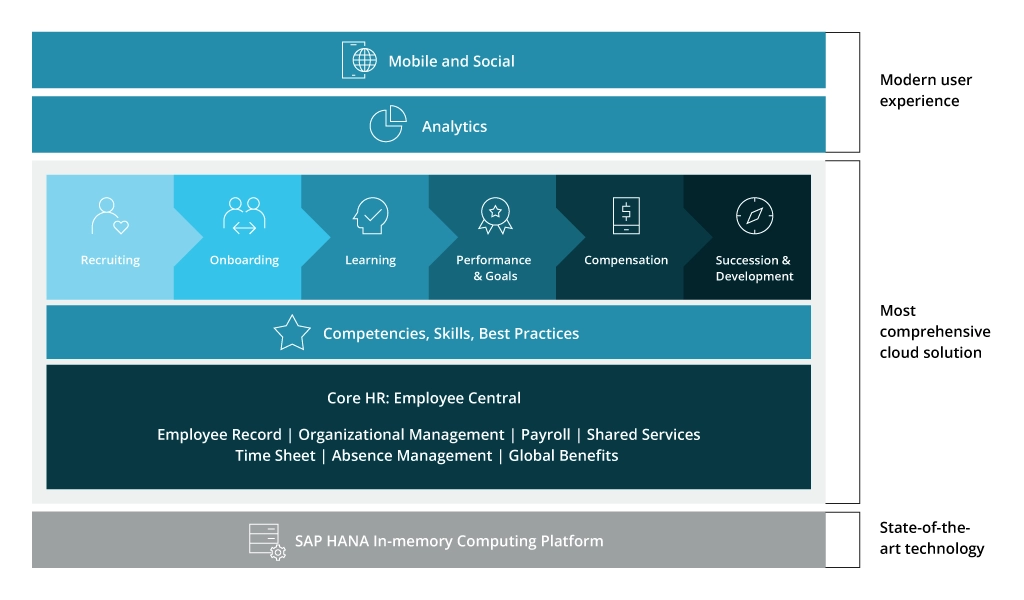Top 3 Platforms for Improving Employee Experience
What Is Employee Experience and Why Measure It?
Employee experience (EX) is the sum of interactions and perceptions your people develop at every touchpoint in their employee life cycle — from hiring and onboarding to retention or separation. Similar to customer experience (CX), employee experience is shaped by the quality, consistency, and effectiveness of workflows your organization adopts to support HR operations and workforce development.
The main employee experience advantage is higher engagement. Satisfied workers are less likely to show signs of absenteeism or intent to quit. Generally, 87% of leaders agree that a superior EX helps retain and attract talent, and to do so, many are investing in new employee experience technology.
However, just half of employees think their employer delivers on the experience they promised. Moreover, many also don’t feel sufficiently supported and prepared for the new challenges at work.
Because employee experience is a combination of different factors — organizational processes, communication practices, diversity and inclusion, and career progression initiatives — uncovering problematic areas is challenging.
Modern employee experience solutions help leaders capture employee sentiment through various EX indicators and translate these into better organizational policies and practices.
Key EX Metrics to Measure
EX metrics help quantify the internalized employee perceptions through interpretable measures to understand better the state of employee engagement, satisfaction, and productivity. The following metrics also help business leaders make more informed decisions regarding workforce development, succession planning, and new technology investments.
- Employee Net Promoter Score (eNPS). Calculated on a scale of 0 to 10, eNPS says how likely employees are to recommend their current place of work. It is a good proxy measure for employee satisfaction, engagement, and likelihood to stay.
- Employee Engagement Score shows the strengths of mental and emotional connection employees feel toward the organization. It helps better track the attitudes toward company culture, workplace policies, and management practices to understand job fulfilment, empowerment, and satisfaction levels.
- Employee Retention Rate tracks how many employees leave your company over a period of time. Low retention (and subsequent high staff turnover) strongly indicates HR problems for specific roles or functions.
- Leadership Effectiveness Score measures how well people in leadership roles support, empower, and communicate with their subordinates. Given that 70% of the variance in employee engagement is determined solely by the manager, it is an important EX metric to track.
- Individual KPIs. Each team and/or role should include individual productivity and performance indicators. Individual KPIs help set role objectives, monitor performance, and provide fairer feedback during peer reviews.
Benefits of Adopting an Employee Experience Platform
Recruitment, onboarding, performance management, compliance, and workforce development — a lot of HR processes are now at least partially digital. However, many of these workflows are often isolated across different software apps, ranging from legacy HR information systems (HRIS) to more modern, cloud-native digital workplace solutions. Then, there are also manual processes, with 65% of HR leaders admitting they still have paper-based or offline processes that could be digitized.
An employee experience platform (EXP) is purpose-built software for improving employee experiences across different touchpoints. It helps consolidate different workflows, establish streamlined people management processes, and collect qualitative and quantitative insights about employee well-being, engagement, and productivity.
Organizations gain the following benefits by investing in a digital employee experience platform.
Data and Workflow Consolidation
Traditionally, HR data, like organizational structure, payroll information, and employee performance metrics, is siloed across different systems. This results in data islands and fractured workflows, requiring constant switching between different systems.
An employee experience solution can be a centralized hub for aggregating all people's insights — from job descriptions and skills inventories to salary data, learning and development (L&D) programs, and employee offboarding activities.
For instance, Infopulse helped a mining enterprise with 100,000 employees deploy a digital workplace solution. Previously, the company relied on several disparate legacy IT systems to run its people operations. To consolidate data and harmonize workflows, our team has developed a new cloud-based solution offering unified access to corporate data and organizational process management (absence management, approval requests, expense reimbursement processing, and more).
Improved People Analytics
Every organization strives to collect organizational, performance, and talent data to make more informed HR decisions, ranging from capacity planning to upskilling initiatives. Although the means to collect data are abundant, data quality and subsequent analysis are common bottlenecks. Nine in ten companies conduct regular employee surveys, but 70% also say the collected data isn’t adequate for their needs.
Modern employee experience software helps continuously collect and analyze a wide range of data points, from individual KPIs and productivity metrics to aggregated insights on training competition, employee retention, cost per hire, and more to improve business outcomes.
Productive Remote Work
Many companies remain divided on the merit of remote work. Companies in the ‘against camp’ cite low productivity and poor communication as the main reasons for returning the workforce back to the offices. However, these problems don’t necessarily disappear when people return to their cubicles. They are often the symptom of poor organizational practices and lack of technology rather than remote work per se.
EXPs help establish better communication flows between teams and departments by providing integrated knowledge management, chat, and virtual meeting tools. Moreover, modern solutions offer ample productivity add-ons, ranging from automatic meeting transcription to advanced information search capabilities, powered by generative AI. By adopting such solutions, companies can address the common challenges of remote work more effectively.
Better Talent Management
Great EX is a strong ‘selling factor’ for attracting and retaining top talents. Employee experience software helps create a positive first impression among new hires by streamlining the standard onboarding tasks like paperwork completion, equipment provisioning, training completion, and more. Effective onboarding improves new hire retention by 82% and productivity by 70%.
Our team recently helped a large retailer implement a new employee experience platform to streamline full-cycle recruiting, onboarding, and talent management. Based on SAP® SuccessFactors the new system seamlessly supports the HR team through the entire recruiting lifecycle — from candidate sourcing and evaluation to quick onboarding, designed in compliance with corporate policies.
EXPs also often include learning and development modules, allowing HR teams to conduct skills assessments and then create personalized learning paths for professional development to support workforce development.
Top 3 Employee Experience Platforms to Consider
The growing employee experience software market has a roster of top contenders. To help you narrow your search, we highlight the three leaders in the space — Microsoft Viva, SAP SuccessFactors, and Qualtrics XM.
Microsoft Viva
SAP Success Factors
Qualtrics XM
Knowledge management
- AI-powered content search and discovery with Copilot
- Personalized knowledge pages and news feeds
- Cross-company content aggregation and curation
- Personalized employee pages with favorite apps
- Secure document storage and exchanges
- Guided experience for navigating complex business processes
Not available
Communication tools
- Microsoft Teams chat
- Employee content feeds
- Personalized email digests
- Virtual events and live broadcasts
Internal company news feed and digital workspace updates
Not available
Payroll and benefits management
Not available
- Integrated payroll processing across multiple countries with localization
- Time tracking and leave management
- Org structure management tools
- Self-service access to information on pay and benefits
Not available
Recruiting tools
Not available
- Job requisition management
- Applicant tracking system
- Recruitment marketing
- Candidate relationship management
- Onboarding management
- Candidate experience management
- Onboarding and new hire surveys
- Exit interviews
- Integration with popular ATS and HRIS for feedback management
L&D features
- Centralized Learning Hub
- Personalized learning paths and collections
- Reports on assigned training completion and learning trends across the organization
- Integrated Learning Management System
- Certification requirements tracking and management
- Learning analytics on progress and outcomes
Point-and-click data modeling tools to evaluate employee skill sets, identify gaps, and administer training
People analytics
- Advanced tools and prebuilt analytical dashboards for personal, team, and leadership insights
- Custom people analytics dashboards with prebuilt analysis accelerators
- Employee engagement analytics
- Employee feedback collection and analysis tools
- HR and people metrics tracking & analysis
- Interactive reporting dashboards
- 360-Degree feedback and structured performance reviews
- Data integration across core HR, talent management, financials, and third-party systems
- Employee journey analytics
- Employee listening and sentiment analysis tools
- Pulse surveys and 360-degree feedback
- Diversity equity and inclusion insights
- Integrations with other data analytics tools like Salesforce and Tableau
Employee OKRs and KPIs
- OKR Management tools
- Progress insights and reports
- Employee goal management
- Tools for ongoing feedback and check-ins
360-employee development tool
Compensation management
Not available
- Compensation planning
- Pay equity analysis
- Bonus and incentive program management
Not available
Microsoft Viva
Microsoft Viva is a modular employee experience platform built with the best of Microsoft's technology. It slots perfectly with other business tools that many organizations already use, including Microsoft Teams, Microsoft 365, and Dynamics 365, allowing companies to create effective information flows between systems and departments.
Available both as part of a Microsoft 365 subscription and as an add-on license, this EXP includes tools for:
- Internal communication and knowledge management (Viva Connections, Viva Engage, and Viva Amplify)
- People analytics and performance management (Viva Insights, Viva Glint, Viva Pulse, and Viva Goals)
- Learning and development (Viva Learning)
The platform boasts superior data management capabilities because Microsoft Viva is part of the Microsoft ecosystem. It centralizes access to all knowledge resources and integrates helpful information into daily workflows. Viva Topics, for example, uses AI to automatically aggregate data from all connected Microsoft 365 apps and provide employees with personalized news feeds and contextually relevant information based on their search. People analytics tools (Viva Insights & Viva Glint) work similarly and provide a cross-organization view of the latest trends in employee activity and performance.
Generally, Microsoft Viva’s strengths are knowledge management and integrated internal communication. On the downside, it doesn’t offer tools for other HR processes, namely recruiting, compensation management, and payroll administration. However, this is the area where the second leader on the list excels.
SAP SuccessFactors
SAP SuccessFactors is a cloud-based HR platform with a stack of competitive features for digital employee experience management. Similar to Microsoft Viva, it includes a range of submodules to streamline different human capital management processes:
- SAP SuccessFactors Employee Central — a global HR platform allowing leaders to support HR compliance, benefits management, absence management, and time tracking among other capabilities.
- SAP SuccessFactors Document Management Core enables centralized HR document storage, management, and exchanges.
- SAP SuccessFactors Work Zone — a digital workplace solution offering a single-pane view of corporate communication, guided experiences for content discovery, and knowledge sharing.
- SAP SuccessFactors Recruiting and Onboarding modules help create efficient global talent sourcing workflows, applicant management, and onboarding experience.
- SAP SuccessFactors Learning — a robust LMS for content creation and distribution with integrated learning analytics.
- SAP SuccessFactors Workforce Analytics delivers comprehensive workforce intelligence across 2,000+ predefined metrics for HR, talent, and other metrics, plus the ability to build custom dashboards.
Compared to Microsoft Viva, SAP SuccessFactors cover a greater spectrum of HR processes, starting with talent sourcing, candidate experience management, and subsequent payroll administration. The Payroll module is adapted to over 100 local regulations and requirements with further options for customization.
The HR Analytics module also has some robust features, particularly around data integration. You can connect insights from all other SAP modules and third-party tools to get a 360-degree view of your workforce. Apart from using available reporting dashboards and analytics tools, you can also easily run ad hoc analysis using SAP Analytics Cloud.
Qualtrics XM
Originally designed for feedback collection and surveying, Qualtrics built out a suite of analytics solutions for quantitative and qualitative research across functions, including HR.
Qualtrics XM for employee experience management provides point-and-click data modeling experience to track:
- Employee engagement to gain personalized insights, generated by Qualtrics AI and monitor workforce trends in real-time using pulse surveys.
- Employee lifecycle performance to better understand employees' experiences at different stages of their journey to identify friction and improve operational processes.
- People analytics that includes behavioral insights and quantifiable data points on the state of employee satisfaction and productivity.
Effectively, Qualtrics XM extends an AI-driven analytics layer across your organization, allowing leaders to capture more EX data and cross-correlate it with specific business outcomes. The Manager Assist feature, for example, provides leaders with a unified dashboard for processing team feedback, tracking team performance, and developing better strategies for ensuring team engagement. CrossXM, in turn, helps merge data from all connected systems — from NPS and CSAT surveys to employee KPIs — to better evaluate the impacts of different people initiatives. Thanks to integrated access to the world’s largest database of Experience Management Benchmarks, you can also track how you measure against your industry peers in terms of specific metrics like diversity or employee engagement.
Overall, Qualtrics XM is a great business intelligence add-on for companies who want to build a data-driven people culture.
Final Thoughts
Like CX, employee experience has become a key competitive differentiation of leading organizations. Companies with a stellar EX tend to enjoy faster time-to-hire, lower employee turnover, and higher economic performance — and employee experience platforms like Microsoft Viva, SAP SuccessFactors, and Qualtrics XM help deliver these outcomes.
![Employee Experience Platforms [banner]](https://www.infopulse.com/uploads/media/1920x528-top-3-platforms-for-improving-employee-experience.webp)









![CX with Virtual Assistants in Telecom [thumbnail]](/uploads/media/280x222-how-to-improve-cx-in-telecom-with-virtual-assistants.webp)
![How to Build Enterprise Software Systems [thumbnail]](/uploads/media/thumbnail-280x222-how-to-build-enterprise-software-systems.webp)
![Super Apps Review [thumbnail]](/uploads/media/thumbnail-280x222-introducing-Super-App-a-Better-Approach-to-All-in-One-Experience.webp)
![IoT Energy Management Solutions [thumbnail]](/uploads/media/thumbnail-280x222-iot-energy-management-benefits-use-сases-and-сhallenges.webp)

![5G Network Holes [Thumbnail]](/uploads/media/280x222-how-to-detect-and-predict-5g-network-coverage-holes.webp)
![How to Reduce Churn in Telecom [thumbnail]](/uploads/media/thumbnail-280x222-how-to-reduce-churn-in-telecom-6-practical-strategies-for-telco-managers.webp)
![White-label Mobile Banking App [Thumbnail]](/uploads/media/thumbnail-280x222-white-label-mobile-banking-application.webp)
![Money20/20 Key Points [thumbnail]](/uploads/media/thumbnail-280x222-humanizing-the-fintech-industry-money-20-20-takeaways.webp)
![Deepfake Detection [Thumbnail]](/uploads/media/thumbnail-280x222-what-is-deepfake-detection-in-banking-and-its-role-in-anti-money-laundering.webp)